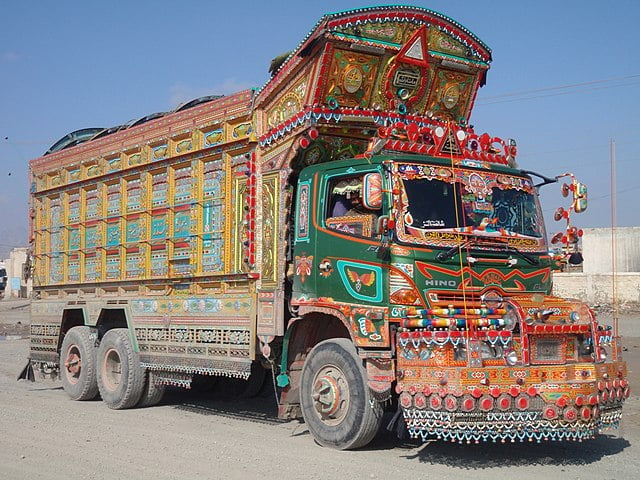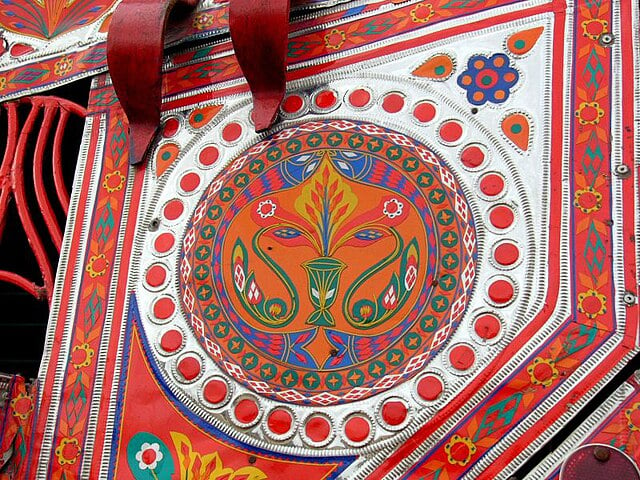Pakistani truck art is one of the most colorful and complex forms of folk art and has become a cultural symbol of the nation. This artistic form, which started in the 1920s, is not only beautiful but also tells a story and represents culture while also beautifying the roads.

This article is a brief on the living heritage of Pakistani truck art, its historical evolution, and how the world can learn from it to promote Pakistan’s soft power.
History and Origin
Pakistani truck art dates back to the 1920s when Bedford trucks began to take over the streets. At first, only simple floral motifs or phool patti were used to embellish these trucks. As the trucking business grew, so too did its associated artistry. By the late 1940s, truck drivers started ornamenting their vehicles with floral designs featuring portraits of Sufi saints, among other culturally important personalities. This transformation laid the foundation for truck art as a separate genre in Pakistan; it is known for its vivid colors and complex patterns.

During the 1960s, political themes started to appear on the trucks along with the traditional ones. The socio-political landscape of that time can be seen reflected in the display of portraits of political figures like Ayub Khan. Truck art has thus become a mixture of political and cultural elements, a prominent form of expression that speaks to different aspects of Pakistani society.
The Economic and Cultural Significance of Truck Art in Pakistan
Truck art is not just a decorative painting but a cultural element of Pakistan. Every truck is a canvas of stories that can talk about the driver’s identity, regional affiliations, and beliefs. The art usually includes Islamic motifs, Urdu poetry, and a bright representation with floral patterns, which, together, can express a visual narrative that is appealing to the local and national pride.
Beyond just aesthetics, truck art is also significant in the economy in that it puts food on the tables of thousands of artists across the country. Approximately 50,000 people are involved in workshops dedicated to this craft in Karachi alone. The economic effect is huge; many truck drivers spend a great deal, sometimes two years’ salary, to ensure their trucks stand out in a competitive market.
The methods used to produce truck art showcase a mix of skills and contemporary inspirations through a range of materials, like paints and mirrors, to craft handmade designs that decorate the entire vehicle’s surface area with creativity and flair. The age-old practice of ‘tanka’ involving the use of threads in fabric stitching has also left its mark on the patterns found in present-day truck decorations. The process is not just decoration; it is an intensely personal process for many drivers who consider their trucks an extension of themselves and have a strong attachment to that. Many people consider decorating their vehicles to be a crucial element as it is their means of livelihood.
Over the past few years, Pakistan has understood the possibility of truck art as a means of enhancing the soft power of the country in the international arena. Soft power is the ability to influence others by attraction rather than by coercion, and usually through culture and values. Pakistani truck art is an ambassador of the country’s rich heritage on global platforms.
Various countries have organized exhibitions of Pakistani truck art, offering a chance to engage with this particular aspect of Pakistani culture. They also foster cross-cultural understanding and appreciation while highlighting artistic talent found within Pakistan. When Pakistan can present truck art on international stages, it can change its narrative from one that is primarily associated with conflict to one that highlights creativity and cultural richness.
Beyond its role in enhancing the aesthetic appeal of long-haul trucks and engaging in diplomatic activities, truck art also reflects and comments on social issues in Pakistan. The other issue is that some trucks have messages about social justice or missing children, and to this end, they use their presence on the roads to create awareness of important causes. This makes its role in society today and then as well as artistic as well as social.
Tourists visit the country to buy authentic pieces of art. This has led to tour operators including visits to truck art workshops to educate the tourists about this art while at the same time supporting the local economies. Thus, including truck art in Pakistan’s tourism promotion will help the country improve its international reputation and, therefore, increase the nation’s economic development.
Challenges Facing Pakistani Truck Art
However, truck art in Pakistan faces certain challenges that threaten its continuation. Handcrafted products are a consequence of the availability of mass-produced, cheaper alternatives, and this, coupled with low wages and limited resources, often forces artists to stop trying to pass on the craft to the younger generation.
Lack of institutional support also poses a challenge to the bid to conserve this heritage, and over commercialization of the art may be undermining its cultural significance. Moreover, the use of traditional materials is also accompanied by environmental concerns, and the low level of global awareness of the art form limits its potential to be used in the promotion of Pakistan’s cultural identity. These challenges must be met to preserve truck art as a lively national heritage symbol.
Conclusion
Pakistani truck art is a clear example of the country’s cultural and artistic heritage. The progression from simple decorative patterns to full-blown narratives indicates changes in society as a whole; it also brings economic benefit to many artisans. Since Pakistan aims to boost its global soft power, truck art could be used for cultural diplomacy and tourism. In this way, Pakistan can change the world’s perception of the country’s culture and demonstrate the diversity and innovation of its people. Not only does Pakistani truck art have a rich tradition to preserve, but it also has a future that combines the best of tradition with innovation, which endorses the best outcomes.
If you want to submit your articles and/or research papers, please visit the Submissions page.
To stay updated with the latest jobs, CSS news, internships, scholarships, and current affairs articles, join our Community Forum!
The views and opinions expressed in this article/paper are the author’s own and do not necessarily reflect the editorial position of Paradigm Shift.
Ruqia Akhter Malik is pursuing Defense and Diplomatic Studies at Fatima Jinnah Women's University. With a particular interest in diplomacy, Ruqia is passionate about fostering international understanding, promoting peace, and resolving conflicts. She is eager to explore the diplomatic relations, negotiation strategies, and cultural diplomacy to contribute to a more peaceful and interconnected world.



